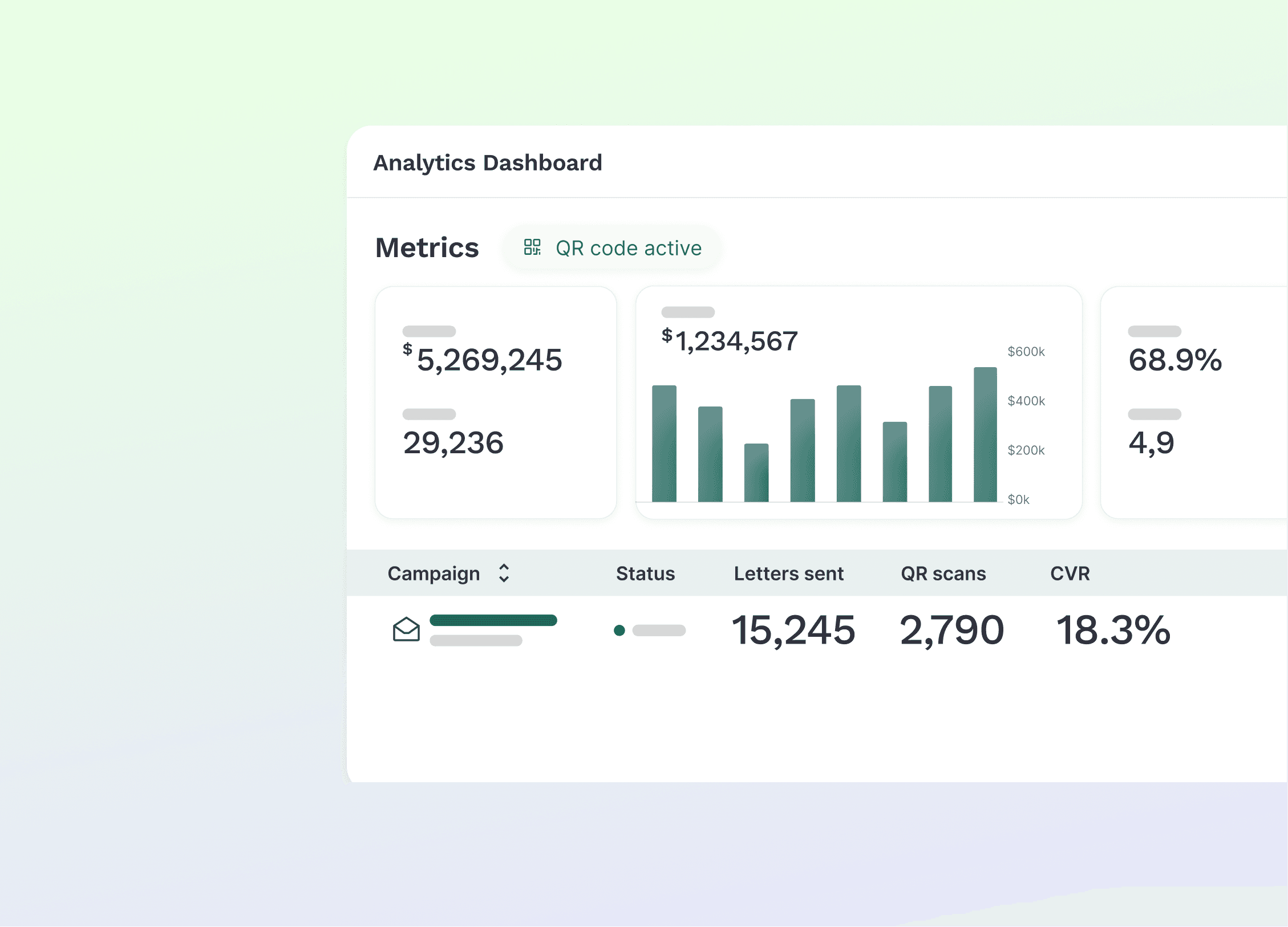5 Ways to Track Direct Mail Campaign Performance
April 16, 2025
In direct mail campaigns, tracking performance is key to understanding success and improving results. Here are 5 simple ways to measure how well your campaign is doing:
Unique Tracking Codes: Assign specific codes to each mailer to track purchases or responses.
Personalized URLs (PURLs): Use unique web links to connect offline mail to online actions.
QR Codes: Add scannable codes to mailers for quick access to landing pages and track scans.
Dedicated Phone Numbers: Use campaign-specific phone numbers to measure call responses.
Response Analysis: Analyze metrics like response rates, conversion rates, and ROI to evaluate overall performance.
Quick Comparison
Method | Key Benefit | Example Metric |
|---|---|---|
Tracking Codes | Tracks specific offers | Conversion rate |
PURLs | Measures online engagement | Click-through rate |
QR Codes | Tracks mobile responses | Scan rate |
Dedicated Numbers | Monitors phone interactions | Call volume |
Response Analysis | Evaluates overall success | ROI |
Direct Mail 101: Part 5 of 5 – Mailing and Measuring for Success
1. Using Tracking Codes
Tracking codes help connect customer responses directly to specific mailings, making it easier to measure ROI accurately.
Setting Up Tracking Codes
Tracking codes can be barcodes or promotional codes. These are added to mailers so they can be redeemed for in-store purchases, online orders, or phone transactions.
Each mailer should have its own unique tracking code. Key attributes of an effective tracking code include:
Easy to read and enter
Clearly visible on the mailer
Consistent in format
Short enough to minimize errors
Key Tracking Code Features
Tracking codes offer several advantages for evaluating campaign success:
Feature | Benefit |
|---|---|
Unique Identification | Matches specific responses to individual mail pieces |
Multi-channel Tracking | Functions across online, phone, and in-store transactions |
Response Attribution | Tracks conversion rates for each campaign |
Data Collection | Gathers detailed insights on customer behavior |
Setup Guidelines
To set up an effective tracking code system:
Create a Standardized Format
Develop a consistent structure for your codes that includes campaign details and launch dates. For example, "SPRING25-0401" could represent a spring campaign starting on April 1.Train Your Team
Ensure your staff knows how to process and record tracking codes accurately to maintain reliable data.Use Scanning Systems
Automated barcode scanning reduces human error.
It's important to regularly review your tracking system to maintain data accuracy. Consider using automated validation tools to verify codes instantly and provide real-time performance insights.
2. Creating Custom URLs
PURLs (Personalized URLs) make it easy to track individual engagement by connecting mailed pieces to specific online actions. Think of them as unique tracking codes that bridge offline mail with detailed online behavior, giving marketers better insights into campaign performance.
What Are PURLs?
PURLs are unique web addresses that direct recipients to personalized landing pages. These URLs often include identifiers like names or codes. For example:
www.campaign.com/john.smith
www.offer.com/spring2025/js12345
Why Use PURLs?
PURLs bring several advantages when used in direct mail campaigns:
Benefit | What It Does | Why It Matters |
|---|---|---|
Response Tracking | Tracks which recipients engage online | Helps measure individual conversions |
Data Insights | Collects detailed visitor behavior | Reveals engagement patterns |
Offline to Online | Links mail campaigns to online actions | Creates a seamless customer journey |
Real-Time Monitoring | Tracks responses as they happen | Allows for quick campaign adjustments |
Studies show that adding PURLs can boost campaign response rates by 30% to 100% [5]. This jump comes from combining personalization with easy online access. Pairing PURLs with other tools also gives a complete view of campaign success.
How to Set Up PURLs
Follow these steps to ensure your PURLs work effectively:
Organize Your Data
Prepare your mailing list with key personalization details like names, demographics, or purchase history.Design Personalized Pages
Create landing pages that adapt to each recipient. Many campaigns use this to showcase tailored offers [4].Set Up Tracking
Use analytics to monitor visits, time spent on pages, form submissions, and conversions.Test Before Launch
Check that all PURLs lead to the correct pages and display personalized content. Regular testing ensures everything runs smoothly.
PURLs not only make tracking easier but also enhance the overall customer experience by seamlessly connecting offline and online interactions.
3. Adding QR Codes
Recent data reveals that 75% of consumers expect to use QR codes [6].
QR Code Basics
QR codes can hold up to 4,000 characters - far more than traditional barcodes [6]. They allow users to quickly access personalized landing pages, payment portals, appointment schedulers, product details, and account management tools.
This makes it easier for marketers to track engagement and simplify customer interactions. For instance, Ashley Homestore used QR codes in their direct mail campaigns to personalize each mailer with the recipient's nearest store location, making it easier to book in-store consultations [6].
With these basics covered, QR code tracking provides even greater insights into user behavior.
QR Code Tracking Features
QR code analytics break down campaign performance with key metrics:
Tracking Metric | What It Measures | Why It Matters |
|---|---|---|
Scan Location | City/state of scan | Understand geographic trends |
Time Stamps | When scans occur | Identify peak engagement times |
Device Type | iOS or Android | Optimize for the right platform |
Unique Scans | Number of individual devices | Gauge true reach |
Total Scans | Overall scan count | Measure campaign success |
For example, Spectrum Mobile used QR codes to direct customers to a cost savings calculator, combining engagement tracking with immediate value [6].
QR Code Design Tips
Once tracking is set up, focus on creating QR codes that encourage people to scan:
Provide clear instructions: Add prompts like "Scan with your smartphone camera." This is especially helpful since only 31% of people aged 65+ have recently used QR codes [6].
Blend with your branding: According to Keypoint Intelligence's 2023 survey, adding digital links to direct mail can boost response rates by 9% [7]. Customize QR codes with brand colors, logos, or dynamic features for better tracking and visual appeal.
Test thoroughly: Ensure QR codes work across different devices, verify landing pages, and check performance under various lighting conditions.
"We've decided not to go completely electronic, as having a multi-channel engagement strategy increases our retention rates. For example, some people will take a postcard and hold onto it until they are ready to renew. Personally, postcards on my fridge are a reminder of the things I don't necessarily have time to do right away. And everybody has enough email." – Ameet Shahani, Director of Technology for CPH & Associates Insurance, Inc. [6]
4. Dedicated Phone Numbers
Dedicated phone numbers provide a straightforward way to measure the success of your campaigns beyond digital tracking. By using these numbers, you can analyze call data to understand the direct impact of your marketing efforts. Here's how to set up, measure, and manage phone tracking systems to improve your campaign insights.
Phone Tracking Setup
Setting up dedicated phone numbers involves a few key steps:
Setup Component | Purpose | Key Consideration |
|---|---|---|
Number Selection | Identify specific campaigns | Match your local area code |
Call Forwarding | Route calls to your main line | Ensure seamless redirection |
Recording System | Save conversation data | Include playback options |
Analytics Integration | Measure performance | Enable real-time reporting |
Using numbers that share your business's area code can make recipients feel more comfortable and increase trust [1]. Many call tracking platforms are available, with features like multiple tracking numbers and detailed analytics starting at $30 per month [9].
Call Tracking Results
Call tracking systems provide essential metrics that help refine your marketing strategies:
Metric Type | Measures | Business Impact |
|---|---|---|
Call Volume | Total calls received | Indicates campaign reach |
Lead Source | Where calls originate | Shows channel effectiveness |
Call Duration | Length of conversations | Reflects engagement quality |
Peak Times | High activity periods | Helps with staffing decisions |
First-time Callers | Ratio of new contacts | Tracks customer acquisition |
These metrics allow businesses to evaluate campaign performance and make data-driven adjustments. For example, Dynamic Number Insertion technology can identify the exact source of inbound calls, offering detailed insights [8].
Managing Your Phone Tracking System
To get the most out of your phone tracking system, focus on these three areas:
Staff Training
Ensure your team is trained to categorize leads and record call details accurately.Technical Infrastructure
Modern call tracking platforms often include:Call recording and playback
Real-time analytics dashboards
Integration with tools like Google Analytics
Custom call tagging options [10]
Performance Monitoring
Regularly track missed calls, response times, call quality, and conversion rates to fine-tune your campaigns.
"By implementing a standard call tracking protocol, you'll be able to learn more about your audience and maximize the profitability of every call." - Neil Patel, Co-Founder of NP Digital & Owner of Ubersuggest [8]
5. Response Analysis
Response analysis evaluates how well your direct mail campaigns perform by connecting mailing lists to purchase data. This helps identify what worked and shapes future strategies.
Analysis Methods
Focus on these key metrics:
Metric | Description |
|---|---|
Response Rate | Percentage of recipients who take action |
Conversion Rate | Percentage of responders who make a purchase |
Customer Lifetime Value | Total revenue generated per customer who converts |
To track these effectively, use a CRM system that monitors interactions across different touchpoints [11].
Data Insights
Analyzing your campaign can uncover important trends:
Insight Category | Measures | Business Use |
|---|---|---|
Geographic Performance | Responses by region | Refines target areas |
Demographic Patterns | Audience segments with the best response | Improves mailing list accuracy |
Offer Performance | Success of specific promotions | Adjusts campaign offers |
Timing Impact | Response trends based on mailing dates | Helps schedule mailings effectively |
By adding custom contact properties in your CRM, you can track when recipients receive mail and measure response timing more precisely [11]. Use these insights to improve your campaign strategy through the steps below.
Analysis Steps
Data Collection Setup
Before launching, set up tracking tools like custom URLs, unique promo codes, and address verification.Performance Monitoring
Keep an eye on key metrics throughout the campaign, such as daily responses, conversion trends, revenue, and ROI.Results Documentation
Record detailed metrics.
Compare outcomes to SMART goals.
Note successes and areas needing improvement [1].
For better accuracy, consider advanced direct mail solutions that include features like automated address validation and data cleaning. Tools like BirdseyePost integrate these capabilities, ensuring reliable tracking and helping you fine-tune your campaigns.
This analysis sets the stage for refining your campaign and achieving stronger results.
Conclusion
Tracking methods play a key role in measuring the success of direct mail campaigns. By combining the techniques outlined below, you can create a system that connects every interaction for a complete performance overview.
Here’s how these tracking tools work together:
Tracking Method | Primary Benefit | Performance Metric |
|---|---|---|
Tracking Codes | Tracks individual offers | Conversion rate |
PURLs | Measures online engagement | Click-through rate |
QR Codes | Tracks mobile responses | Scan rate |
Dedicated Numbers | Monitors phone responses | Call volume |
Response Analysis | Evaluates overall performance | ROI and lifetime value |
When used together, these tools provide a full picture of your campaign's results, capturing both immediate actions and long-term outcomes. This integrated approach ensures consistent tracking across channels and supports data-driven decisions for better results [2].
To get the most out of your campaigns:
Make sure your team tracks and codes leads accurately.
Analyze KPIs to spot trends and areas for improvement.
Use the data to fine-tune your targeting and messaging.
Experiment with different tracking combinations to see what resonates most with your audience.







